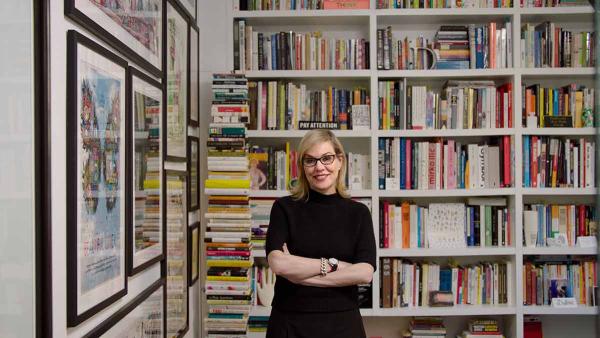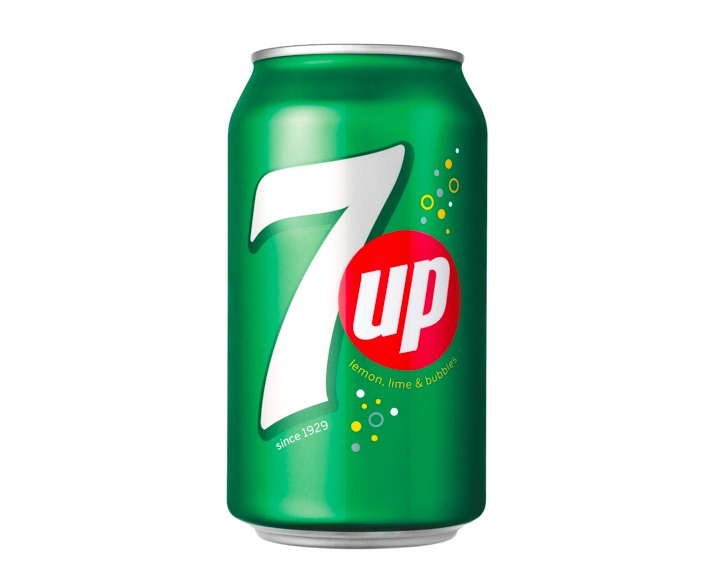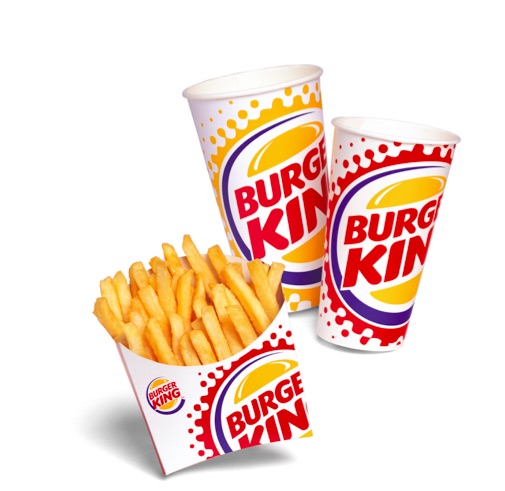2019 AIGA Medalist Debbie Millman
Recognized for skillfully designing both the form and expression as principal of Sterling Brands, alongside the medium by which the designer's voice can be amplified and understood through her award-winning podcast, Design Matters; for actively designing the pedagogy for the next generation of practitioners at the School of Visual Arts (SVA), Masters in Branding; and for her years of service and commitment to AIGA.

Recognition
2019 AIGA Medal
Born
1961
Biography by Steven Heller
March 25, 2019
Follow Us
It is February 4, 2005, and the jaunty, percussive rhythm of “Ghostwriter” by Rjd2 fades out as Debbie Millman delivers the first of many erudite opening monologues from the desk of her Empire State Building office. This is an auspicious moment in the professional life of the president of the design division of Sterling Brands, and a giant leap from her commercial work. It is the debut of her new podcast that “takes you into the provocative and stimulating world of design and branding as it intersects with contemporary culture”; the first live, weekly call-in show of candid interviews with design makers, shakers, and thinkers.
Now in its fourteenth year and numbering 400 episodes, Design Matters started as a platform for a wide range of designers, illustrators, and art directors to discuss their methods, motivations, and aspirations absent of artifice. It has since evolved into an even wider berth of popular culture, art, politics, and science with Millman emerging as a vigorous and probing voice for the personalities whom, she believes, “make a difference.”
Millman’s interview voice is pointed and engaging. It attracted such a growing and loyal audience that by 2011 the podcast was honored with the People’s Choice Cooper Hewitt National Design Award. In the years sinjesce, iTunes has designated it one of the top 15 podcasts of 2015, and Business Insider called it one of the best podcasts in the world. The Webby Awards recognized it as an honoree in 2018.
Today, Design Matters is a pillar in the cultural space with nearly 25 million total downloads since 2005 and an average weekly audience of 100,000 listeners. But the podcast actually started by chance when Millman received an offer from the Voice America Business Network to create her own podcast in exchange for a fee. (“Yes, I had to pay them,” Millman says). After 100 episodes, Millman was invited to publish Design Matters on Design Observer by its cofounder, Bill Drenttel. In 2010, Sterling was sold and moved from the Empire State to new downtown offices, and Millman relocated her studio to the School of Visual Arts in New York City, where she’d founded the Masters in Branding Program the year before. Design Matters is now recorded at the specially built podcast studio at SVA and while it no longer broadcasts live, it still maintains a live audience of Branding students during the taping of each episode.
As part of DC Design Week, Debbie Millman brought to life her popular podcast Design Matters at the National Building Museum with guest Abbott Miller (November 2016). Image courtesy of Debbie Millman.

7Up. Sterling Brands, New York City (2014). Image courtesy of Debbie Millman. “As PepsiCo’s third largest global brand, 7Up had a look that was borderline clinical. The brand needed a redesign that would connect with a broader audience. The new global identity system embodies the new positioning around refreshment and flair, building on the brand’s witty and lighthearted personality.”

Burger King. Sterling Brands, New York City (2001) Image courtesy of Debbie Millman. “Burger King is the second largest burger chain in the world, needed to revive its brand and give consumers a new reason to come back. Sterling created a new global positioning that reignited the brand’s passion for taste.”

HOT 97. Debbie Millman, New York City (1999). Image courtesy of Debbie Millman. “From 1993-2005 Millman was the off-staff creative director of HOT 97 in New York City, where she worked with Emmis Broadcasting General Manager Judy Ellis and Promotion Director Rocco Macri to transform the dance music radio station into the world's first hip-hop radio station. Millman created the HOT 97 logo in 1994 and then redesigned it again in 1999, which is still the logo today.”
Millman was born in Brooklyn, New York, on October 29, 1961. Her mother was a seamstress and her father owned his own pharmacy, which she says exposed her to brands when she was little. She went to public schools through high school and then the State University of New York at Albany, graduating in 1983.
Millman's portfolio has been broad both in its scope and level of success: she is the author of six books, president emeritus of AIGA, co-founder of the world’s first Masters in branding program at the School of Visual Arts, editorial and creative director of Print Magazine, and president of Sterling Brands; her illustrations have been featured in publications such as The New York Times, New York Magazine, Print Magazine, and Fast Company, and her artwork shown around the world. But she was not always as confident as her on-air persona suggests. After graduation, she drifted between jobs in freelance design—doing paste-ups and layouts for a cable magazine or as in-house designer for a real estate company—before founding her own small design business. “My first ten years after college were experiments in rejection and despair,” she explains. “I knew that I wanted to do something special but, frankly, I didn’t have the guts.”
That all changed at age 30 when Millman decided to change her life, setting herself the goal to work for Frankfurt Balkind, “the best design firm in the country at that time.” At her interview, Aubrey Balkind offered her a job, but not as a designer. “He didn’t think my work was good enough—and this was all the work I had created in my entire career thus far!” Millman took the job in marketing all the same. A frustrating year later, she was recruited for The Schechter Group, a global communications consultancy. She had never done brand identity but soon found her niche creating packaging design for the firm.
The funk was beginning to lift by 1995, when she was recruited to join Sterling Brands. Millman spent half her life there, starting in sales, skyrocketing to president and then becoming partner. She worked on the Burger King logo, the branding and packaging for Star Wars Episode Two: Attack of the Clones, the global redesign of 7UP, and the Tropicana identity and packaging. “I helped grow Sterling from 15 people when I started in 1995 to 150 people in 2016,” she says with pride.
It was during her middle years at Sterling that Millman hoped to achieve “creative satisfaction that wasn’t commercial.” The impetus came in 2003 when she was personally targeted in an editorial by Felix Sockwell on the design blog Speak Up. Not one to shy from confrontation, Debbie started commenting—stating her position and clearing any misconceptions and misinformation that Sockwell had cast about her. “At the end of the discussion, the overall feeling from everyone was ‘Hey, this Debbie is alright!’ A few days later, I apologized and invited her to become an author on "Speak Up,” recalls blog founder Armin Vit.
Amid the contemporary din of anti-brand rants, no one could have predicted that Millman would become such a significant voice in podcasting. Even she is puzzled. “I find the early shows to be unlistenable. I think it took me about 100 episodes to find my ‘style.’”
“Debbie has the ability to get extraordinarily personal, even intimate, insights from her subjects. At the same time, she encourages them to explore the biggest of big ideas.” — Michael Bierut
Those 100 episodes took dedication—an asset that makes Millman a talented interviewer. “I usually spend about ten hours researching for every one hour of actual interviewing,” Millman says. “I love researching my guests. I usually cull about 25 pages of research from my findings, and then whittle that down to about five pages of questions about their lives. I often say that a good interview is like a good game of pool: You want to shoot one ball in one hole but also leave enough balls on the table in position to successfully shoot the next. I want to be able to pivot if my guest takes the interview in a different direction.”
Millman’s interviews are engaging because she predicates her work on preparation, insight, and poise. “I was always most impressed by the basic honesty with which Debbie talks about her own experiences,” says Stefan Sagmeister, a frequent guest, “and how she is able to bring that stance to her interviews, as well.” Pentagram partner and co-founder of Design Observer Michael Bierut agrees: “Debbie has the ability to get extraordinarily personal even intimate insights from her subjects. At the same time, she encourages them to explore the biggest of big ideas. This ability to shift between scales is remarkable and is at the heart of the value of what Debbie has created.”
“Debbie’s found a way to both capture the moment and expand on its future,” says Design Observer co-founder Jessica Helfand. “Generous and curious, at once a seasoned critic and a spirited participant, her Design Matters archive is a rich time capsule of cultural capital—as valuable today as yesterday, as meaningful tomorrow as it will prove a generation from now. That seems to me not only an unparalleled design contribution but a priceless one.”
Millman selects guests whose work and personality she admires. The list is impressive for its breadth of age, experience, and perspective. It ranges from astrophysicist David Spergel to author and activist Anne Lamott; performance artist Laurie Anderson to veteran journalist Lewis Latham. While in the past Millman primarily talked to designers about design, now her guests include a wider range of creative minds, discussing how they design their lives.
“I am endlessly fascinated by the trajectory of a person’s life,” says Millman. “The choices they make, how they overcome obstacles or handle success, and how they essentially become who they are.”
And the most satisfying guests? “Ones who love to reveal all the secrets of their lives.”